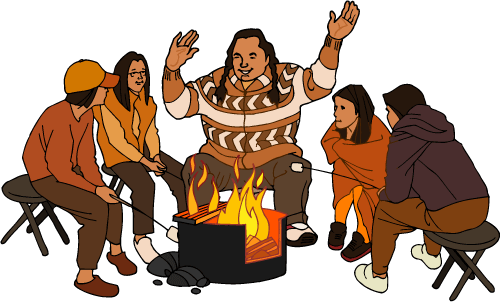Lesson 1.2D: The Narrative Paragraph

We are surrounded by stories. We hear them on the news, the TV, around the dinner table, in our phone conversations. Not only do we hear them, but we tell them as well.
Think about the qualities of a good story. It should accomplish the following:
- move from beginning to end with purpose
- be written in an entertaining and descriptive way
If these ingredients are mixed well, you have probably written a good story, and a good story captures your reader's interest.
Get ready to write your story!
Think Like a Reporter - Gather Your Information
The first quality of a good story is having it move from beginning to end with purpose. A good writer begins to do this by planning the story, by gathering the information needed to write the story.
 Having already looked at two different ways of getting started with writing - brainstorming, mind mapping, and listing - you can use any of these methods to get started with a narrative paragraph. You will, however, need to think a little differently this time. Having already looked at two different ways of getting started with writing - brainstorming, mind mapping, and listing - you can use any of these methods to get started with a narrative paragraph. You will, however, need to think a little differently this time.
A good way to generate ideas for a narrative paragraph is to think like a reporter. A reporter's job is to ask questions. The 5 Ws + How provide a nice entry point into storytelling. Here's an example. Let's say you want to write about losing your first tooth. You would want to generate ideas on the who, what, when, where, why and how of the event. Look at the following example to see how your planning might look.
| Topic: Losing My First Tooth |
| Who? |
me (and my family) |
| What? |
experience of losing my first tooth |
| When? |
when I was 4 years old |
| Where? |
Galiano Island |
| How? |
walking on beachbeach was rocky
I was wearing flip flops and eating a granola bar
I was trying to catch up to my dad
he didn't hear me calling
I tripped and fell
I had to go back to Vancouver on the ferry and get my tooth removed at the Children's Hospital |
| Why? |
tooth was chipped but didn't fall out - it was pushed back into my mouth
went to island clinic - nurse said tooth needed to come out
no one on island to do this - had to rush back to Vancouver |
The rough details have been given and put in order from first to last. This outline will serve as the blueprint for the story. Notice as well that the story details listed are precise. What needs to happen now is to make it interesting and write it in such a way that the reader will want to continue from beginning to end.
 Write Like a Painter - Make Your Story Come Alive Write Like a Painter - Make Your Story Come Alive
Choosing your words carefully is always important when writing, but it's especially important when telling a story. Descriptive words make a story much more interesting for the reader. The words of a story are comparable to the colours that an artist chooses for a painting. They give the story or painting meaning, and they communicate the author or artist's thoughts and feelings. When you write a descriptive paragraph, choose words that will paint the picture, and tell the story as you want your audience to see it.
Here's an example of a narrative paragraph that uses good, descriptive language:
| The sound of a powerboat in the channel grows louder. I can make out the form of a gleaming white cabin cruiser. Looks like a little 25 footer. It's his boat! It's Grandpa's boat! The wet wood of the dock railing feels slimy under my hands, but I lean out farther to see if I can make out Grandpa sitting at the helm. He's come up from Portland, to surprise Fenna. He'll dock his boat right here and tell me how great the fishing is where he's living now, how I've just got to come out with him this summer, catch some Chinook with him. The boat gets closer. He's taking care not to look this way. That's strange, isn't it? A crowd on the lawn like this would make anyone look to the shore. Maybe he can't bring himself to look this way, just yet. |
This paragraph does a nice job of painting a picture for the reader. Descriptive words are used well so that the reader can visualize the scene being described. The writer appeals to many of the five senses (taste, touch, sight, smell, sound). If you really think about it, you could probably make a short film of this scene using the description provided.
Note: Beware of too much description. You don't want to overuse descriptive words and have a story that turns the reader off because it is too wordy and descriptive. One of the things a good storywriter learns is to SHOW and not TELL.
 Now Complete Section Assignment 1.2C: Write Your Story of the assignment template. Now Complete Section Assignment 1.2C: Write Your Story of the assignment template.
|
Summary
Completing this lesson has helped you to:
- select and organize details
- use effective sentences
- write a solid narrative paragraph
- use sentences effectively
- edit and proofread your writing
|

